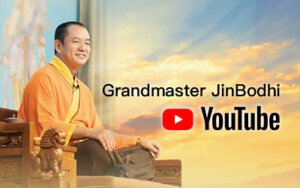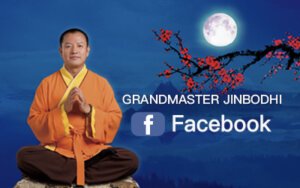Stroll along beautiful old streets lined with elegant traditional buildings. Bukchon offers ancient charm, but before appreciating more of it, be aware that two trials await.
Watch Meditation Grandmaster JinBodhi’s visit to Korea unfold and experience a joyful journey.
Strolling through Bukchon in Seoul
This is Seoul, South Korea. Here, people are often busy and pressed for time; lives here are busy and full of pressures. Now, stop. Turn an ordinary day into a wonderful one.
Meditation Grandmaster Jinbodhi, who turns ordinary lives into extraordinary ones, has finally arrived in Korea!
It is so beautiful.
The Bukchon Hanok Village is an old traditional village in Seoul. It is not a scenic area, but a residential one. It allows people to deeply feel Korea’s traditional cultural heritage.
Grandmaster JinBodhi, who has not been to Korea for a long time, dressed himself as a traditional Korean private school teacher to fully experience the traditional culture.
Greetings to Grandmaster: Please rise.
Let us introduce the three disciples of Grandmaster JinBodhi: Big brother Xu-fu, was known as a child prodigy since he was six. He was chosen to study at a private school. However, his playfulness made him spend 30 years to learn the Thousand Character Text. He has a dream that one day he becomes Grandmaster JinBodhi’s top disciple. Second brother Liang-wu, who is handsome, tall like an electric pole, and with a clear, sharp mind, is currently the imperial guard. As he is often abroad on business trips, he wishes to settle down in one place. Third Brother Xian-zhen has good looks and aura like a general; girls are often captivated by him, but his playful qualities always leave them heartbroken. He hopes to maintain his appearance and be eternally young!
Today, our mission is to visit the Bukchon Hanok Village with the three disciples. We have to pass two checkpoints. The first checkpoint is paper bag hitting. Paper bag hitting is one of South Korea’s traditional games. Place a paper card on the ground, and use the other card to smash against it. Whoever manages to flip over an opponent’s card wins. Usually boys play it more. Pick two from the five paper bags. One will be on defense; the other on offense.
I choose this one. Do I need two? I pick the small one then. Pick one from the two and put it on ground. (Yes, you win if it flips over.) So I have to smash on it.
The first checkpoint is at the Village entrance. One must pass this to enter. Oh, let me try. The result of round one?
(Unfortunately, failed.) Ah, let me try again.
What is the result of the second round?
Oh, failed again. It is not easy. It almost flipped. It is harder than I thought.
(You can pick one disciple to play this round. Who got picked?) Come, you first! Since you are a general, you should have great strength. You seem really strong.
“I’m a handsome general. I’m young and strong. I want to show my strength.”
Energy is released limitlessly!
Oh! What happened! You are a frail General…
Oh, my…
Good luck, paper bag!
Flip it over.
No. Failed again.
Switch to another disciple. Come over, your turn! Ha ha ha…
Who is the second one to be chosen?
Let’s go. Emptiness is form!
It hit right at the center!
It jumped, but it didn’t flip over.
It bounced up and landed in the same place. Continue.
Wow, it is really loud! Your turn. Come over here to prepare. Come on!
Too bad you didn’t work hard at school. Hit!
An extraordinary posture
1. Clear the interference.
2. Lower the body and increase the attacking power.
Will he succeed in one try?
Oh, there is hope!
Again?
How to do it? The last disciple screams, “I need a clue!”
Need a clue? Try once more.
The received clue is Grandmaster’s prophetic power. The paper bag flew up lightly. Is it a failure or success? Between his fingers, the paper flipped over! So, the one who didn’t study hard has done better. The first checkpoint: Paper bag hitting is successfully passed.
Go visit Bukchon Hanok Village! Go Go!
It is truly beautiful! The pine tree over there is beautiful too.
It is a really nice house. Let’s look at this house. Look here. Wow, look, it is a traditional Korean pine door. There are two large iron door knockers. It is very contemporary too. Here is a fingerprint passcode lock, and a doorbell with a face recognition camera. It is truly a blend of traditional and contemporary.
The slate tiles are within hand reach. Each tile is beautifully patterned with eight-petal lotus symbolizing the eight trigrams. Although the garden is small, there is a beautiful pine tree inside. What does it represent? Longevity and health. Pine, cedar, and evergreen are all long life trees. There are two trees, usually representing parents. This is built with layers of real stones and red bricks, and topped with green tiles.
The doors and windows are made of Korean red pine. Usually, they are not painted. Just undergo natural oxidation. As they age, they look remarkable! The natural patterns on it exude its lightness and elegance. Look at that door knocker, at the top, two, four, four, portraying stability and harmony. There are respect and love between husband and wife. It also represents yin and yang.
Like this one on top of the door, this is known as a rafter in China. It signifies family prosperity. His posterity will rise to the top. Look at the corner of the house. It looks like it has been raised. This is not related to weather shields. What does it signify? This is called “an outstanding person” signifying family prosperity, the children will rise and succeed. It is an up-flowing positive energy. Look at the rafters up there. Some are round and others are square. Round stands for sky, for father; square for earth, all directions.
Good. This door is very interesting. I like it a lot. Among ancient architecture materials, if there were no big stones, cement boards, or wood, then people would build it with layers of bricks. This is like the door of a cave, with very strong supporting power. This is an arch. An arch is a classic structure in the eastern architecture. It is amazing.
OK! Good!
Shuttlecock Kicking: To succeed, the carpet must be kept afloat.
It is so pretty!
These are all antiques!
This one is about 200 years old.
“Tea samadhi.”
Self-cultivators in the past, whether in China or Korea, would serve tea to their guests and discuss the Way together. Through the tea tasting process, they explored the ultimate truths of life, and by tasting the tea, they discussed the essence of samadhi. Therefore, here is the tea samadhi.
After passing the first checkpoint, the second checkpoint is shuttlecock kicking. Shuttlecock kicking is a popular game in Korea, and it has become a winter custom. Kicking shuttlecock five times consecutively, if they don’t fall to the ground, you win. Winning the game will be rewarded with the hot handmade omija tea.
Will they pass this checkpoint too?
First round, Second Round, Third Round, and Fourth Round. They failed at all four rounds! Come over here! Put down the knife. You first. Take the knife.
How will it turn out for General?
Oh, one! Ha ha ha…
“I really wish to succeed this time…”
Two! I got it. I will be back! What happened?
Not sure if he has kicked shuttlecock four times?!
OK, another person. Come on! The “Taipei Imperial Guard” failed too…
Switch with another one!
Today’s “star of hope.” He kicks the shuttlecock in a different way.
This one seems a bit better. “I’m Grandmaster’s top disciple.”
The shuttlecock is bouncing off his toes: 1, 2, 3, 4… Successfully kicked 4 times in the second round.
An extraordinary posture
1. Use eye expression to stop the wind.
2. Clear all the obstruction in the way of success.
He is super focused. Will they be able to drink the omija tea?
A tea that has five different flavors: sweet, sour, bitter, spicy and salty. Different people taste different flavors.
“Disciple, you must succeed.”
“Grandmaster, let me try.”
With effort, he successfully kicked five times. Five! He has also completed the mission. Good job!
As expected, awesome job! After 30 years, he can finally stand in front of Grandmaster. The star of today finally became Grandmaster’s proud disciple.
This omija tea is really good! These houses give off a very warm feeling. Koreans, in the past or nowadays, live with good tastes. These buildings are fully incorporated with their culture and traditional philosophies. When I stepped into this special architecture, and as I am sitting here, though the roof is not that high, I feel the warmth. The qi and energy of this house is quite full, also with this wooden floor. In the past, underneath the floor was a burning fire pit to keep it warm. Many old houses still keep this feature. In winter, after walking in cold weather, when we come in, we feel the warmth of home. This is what I like a lot. I welcome everyone to Seoul, South Korea, to visit and experience strolling through old dwellings. It is the feeling of being home of years ago. With a cup of hot tea, this is happiness for me! With or without the sense of meditation, it is a feeling of joy. Very good!

